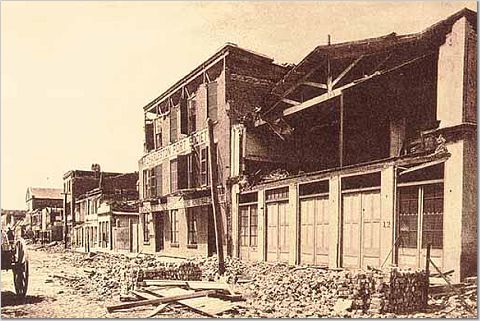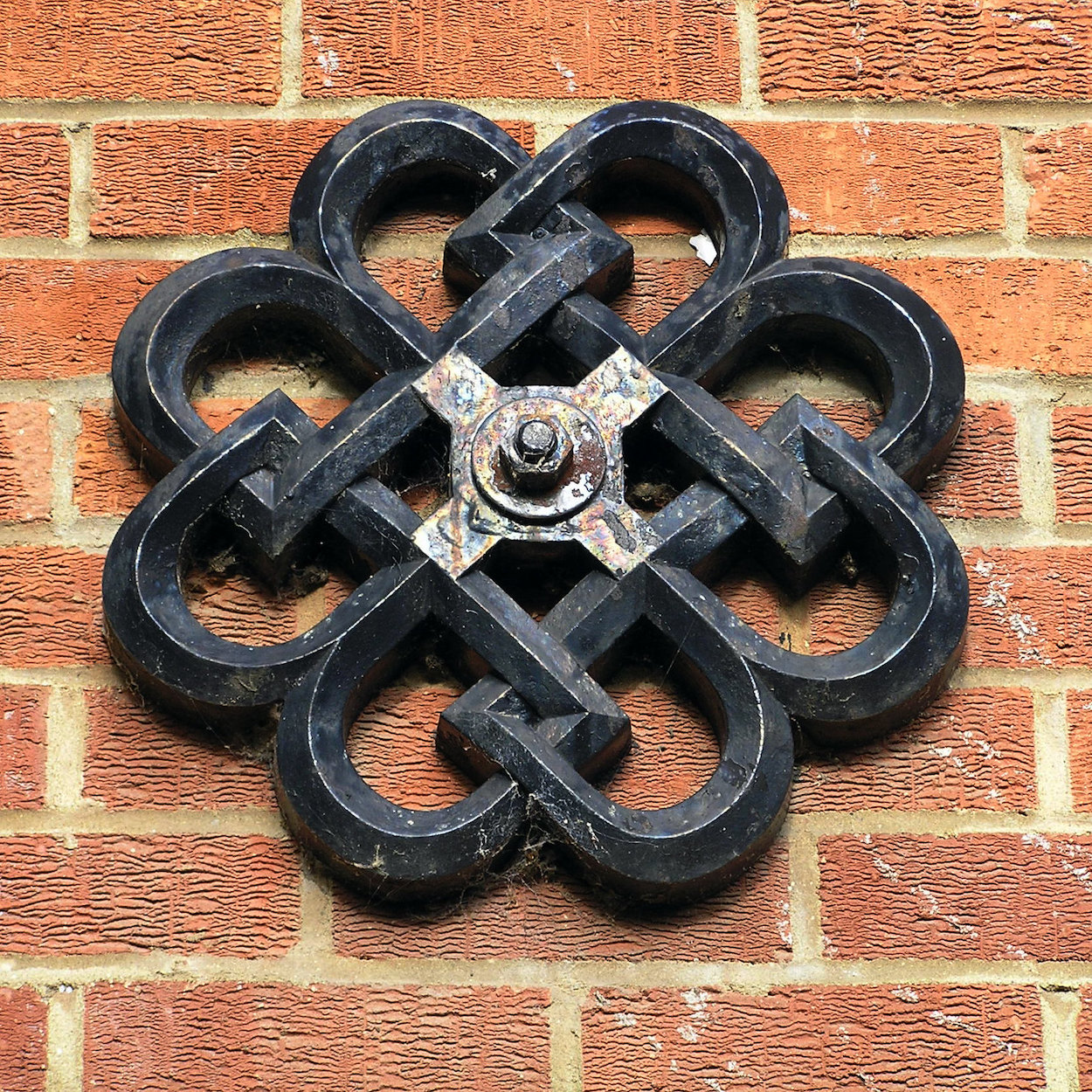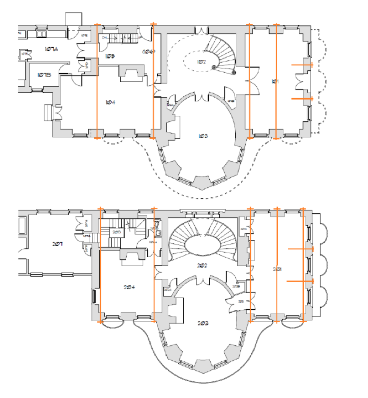Some brick buildings weathered the devastating 1886 Charleston earthquake. Their secret was an ingenious structural element borrowed from Greek and Roman construction.
By Meghomita Das, Palomar Fellow (@meghomita)
Citation: Das, M., 2022, Tie rods aren’t just a pretty facade. Here’s how they help earthquake proof Charleston, Temblor, http://doi.org/10.32858/temblor.274

On the night of Aug. 31, 1886, the people of Charleston, South Carolina, were surprised by a mighty earthquake that would go down in history as one of the most powerful jolts to rattle the eastern seaboard of the United States. Sixty people died, and the quake left a trail of devastation across the city, totaling $5 million ($165 million in 2021) in economic damage.
Several factors made the event significant. Not only was it one of the largest earthquakes to strike the eastern seaboard in history, but the proximity of the epicenter, the high population density of the city at the time, the presence of soft soils and the use of bricks over timber in buildings all contributed to the widespread damage.
The impact could have been far worse, if not for an ingenious, centuries-old engineering solution used to shore up buildings in the hurricane prone south, which stopped them from collapsing and saved numerous lives.
No history to lots of history
Historical records suggest the 1886 Charleston earthquake had a magnitude of 6.9-7.3, which at the time was unusual for an area that had no records of such a large earthquake. Scientists have since discovered evidence for prehistoric earthquakes that occurred in the vicinity of Charleston in the last 5,000 years. The epicenter for the 1886 earthquake is thought to be in Charleston itself. The shock was so intense that it was felt along the eastern seaboard to New York City, as far east as Bermuda and as far west as Louisiana. Since then, several earthquakes of varying intensities have occurred in the area, with reports of chimney damage and collapsed buildings.
In the soft floodplain soils of downtown Charleston, strong ground shaking triggered soil liquefaction and sand boils, phenomena in which water-saturated soils or sand behave like a slurry. Several historic buildings and townhouses collapsed when the ground below became too soft to support their weight.
About 400 aftershocks followed the quake over the next 30 years, according to the U.S. Geological Survey (USGS). More earthquakes have occurred since; on average, 10-20 per year are recorded, with up to five of those being large enough to be felt. The largest was the 1913 magnitude-4.8 Union County earthquake.
During the first half of 2022, an earthquake swarm shook Elgin, South Carolina — about 135 miles from Charleston — with temblors ranging in magnitude from 1.3 to 3.5. The USGS reports that these new earthquakes are not related to the seismic zone in the Charleston area.
These swarms could be aftershocks of an undocumented prehistoric earthquake that happened in the area near Elgin, says John Ebel, a seismologist at Boston College. Similarly, the clusters of earthquakes that we observe in different parts of the central and eastern U.S. could be aftershock sequences from prehistoric earthquakes that could have taken place within the past 1000-2000 years, he says.
Explaining enigmatic earthquakes
Scientists have categorized the 1886 quake and all subsequent events in this area as intraplate earthquakes — temblors that strikes far from the edge of a tectonic plate. Similar quakes of varying magnitudes are felt every year all along the eastern seaboard and even up to Quebec, Canada. Despite the number of earthquakes, the forces driving faults to slip in this region are unclear. “There is no straight answer to the causes behind these earthquakes,” says Thomas Pratt, research geophysicist at the USGS. “It is a bit of a mystery, but we do have some competing hypotheses about what might be causing some of the earthquakes,” adds Anjana Shah, a research geophysicist at the USGS.

Credit: Henry de Saussure Copeland via Flickr, CC BY-NC 2.0
One of the hypotheses behind the seismic activity involves the release of energy along weak planes. Hundreds of million years ago — when the dinosaurs and other reptiles ruled over the landmasses during the Mesozoic period — rifts began dissecting the eastern North American Plate. These rifts pushed the plate apart as the supercontinent, Pangea, broke up to form smaller continents. Over millions of years, these rifts formed basins that were filled with sediments. The faults that define the rifts are now buried deep beneath piles of sediments, but still form potential weak zones along which earthquakes can occur. As the North American Plate moves farther away from Europe and Africa, these former rift zones act as the perfect location for tensional stresses to be released in the form of earthquakes, Ebel says.
The earthquakes strike within linear zones that run roughly parallel to the eastern coast. Some other proposed hypotheses to explain the seismicity include thinning of the crust that creates weak zones for faults to slip, water percolation down to the basement rocks that might trigger some quakes and the presence of other local geological features that concentrate stress. However, both Shah and Pratt caution against identifying a unifying cause behind these quakes. We still do not understand why they are more likely to occur in one area versus the other or what causes this localization, Shah says.
Tying it all together
As the 1886 rupture ripped through downtown Charleston, it toppled buildings and chimneys and caused roofs to collapse. Nearly all eight thousand city structures at the time experienced internal damage and had broken windows. Brick buildings suffered the most damage due to their weight and unreinforced masonry construction. Puzzlingly, some historic brick buildings were left with only minimal damage.
These buildings were safer because they were built with pattress plates and tie rods, according to an assessment done by the Executive Relief Committee comprising of architects and engineers, which was formed after the earthquake. These low-tech structural elements dot the façade of many historic buildings in Charleston and are used to shore brick buildings against damaging sway caused by hurricanes and storms.
Pattress plates are round or decorative cast iron plates installed on the outer walls of masonry buildings. They act as a washer plate to wrought iron (now commonly steel) tie rods that bind the outer masonry façade to the internal structure of the building. The use of pattress plates and iron tie rods comes from past Greek and Roman engineers, who used iron to support load-bearing masonry structures and hold arched piers in place.

Over time, this practice was adopted and improved by different civilizations. The Dutch molded cast iron into diverse shapes to develop decorative motifs for pattress plates. As people migrated to Americas, they brought their practice of using decorative pattress plates and tie rods with them to reinforce the outer masonry façade of their new homes to its internal timber frame.
These plates and tie rods provide superior modes of tying floors and roofs to masonry walls in historic houses, says Craig Bennett, a preservation engineer with expertise in historic masonry in South Carolina. His company uses this mechanism to reinforce and strengthen many historic buildings in Charleston and throughout the southeast. As the building shakes during a quake, unreinforced masonry walls tend to fall outward, destabilizing the roof and floors.
Other modes of reinforcement such as epoxy anchors are not as efficient in securing the masonry, says Bennett. “The important thing about the pattress plate and tie rods is that they pull back the building walls over a larger area, creating less stress unlike epoxy anchors which acts over a limited area and creates a higher concentration of stress.”
These forms of reinforcement work not just for earthquakes but also for any kind of natural disasters that can cause a building to shake or sway violently, such as hurricanes and tornadoes. However, installing them in the wrong way will reduce their efficacy, Bennett says. Ideally, the plate and rods are installed within the floor system with spacing between the rods determined by the location of windows. Installing the rods above or below a window is ineffective as the brick-less window areas do not exert as much weight on to the surrounding brick and create zones of low compression stress in the masonry walls.

For the plate and tie rod mechanism to be effective, the rod needs to be in an area where the natural weight of the masonry can provide good compression on the rods and hold it in place. Having this means that a larger amount of shear force — a force that pushes on a body in opposite directions, such as during shaking — would be required to move that rod out of place.
In Charleston, some buildings already had such plate and tie rod installations to retrofit and reinforce masonry affected by disasters such as an 1811 tornado and an 1885 hurricane. Buildings with the installations weathered the shakes caused by the earthquake, whereas those without the installations crumbled and collapsed. After the earthquake, tie rods and pattress plates were used extensively to reinforce damaged masonry buildings — so much so that they became commonplace among the stately buildings of downtown Charleston. Thus, they earned their moniker of “earthquake bolts.”

Back in 1886, Charleston was a burgeoning city recovering and reconstructing itself after the Civil War. Its population was about nineteen thousand. Today, Charleston hosts a population of one hundred and fifty thousand. If a similar event struck Charleston today, it would cause damages worth an estimated $20 billion and nine hundred deaths. Whether the city will experience another big quake in the future or not, the earthquake bolts will ensure that the historic buildings of Charleston stay tied and bolted together to stand the test of time.
Meghomita Das is Temblor’s Palomar Fellow. She is a Ph.D. candidate at McGill University in Montreal, Canada, where she studies the signals of ancient earthquakes and slow slip events (www.meghomita.com). Palomar Holdings is sponsoring a science writing fellow to cover important earthquake news across the U.S.
References
Wiedman, Jamie Lynn, “Ties that Bid: The Emergence of Iron Tie Rod Reinforcement in Load Bearing Masonry Buildings of Charleston, S.C.” (2012). All Theses. 1340.
- Structures can be both earthquake-resilient and sustainable - July 19, 2024
- Earthquakes rattle Palawan, Philippines: Is the region as stable as we thought? - July 3, 2024
- Seismic retrofit rates highlight inequitable efforts - June 20, 2024

